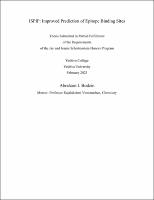Please use this identifier to cite or link to this item:
https://hdl.handle.net/20.500.12202/8788| Title: | ISPIP: Improved prediction of epitope binding sites |
| Authors: | Viswanathan, Rajalakshmi Bodzin, Abraham |
| Keywords: | ISPIP: Improved Prediction of Epitope Binding Sites classifiers linear and logistic regression models ISPRED4 SPPIDER DockPred |
| Issue Date: | Feb-2023 |
| Publisher: | Yeshiva University |
| Citation: | Bodzin, A. (2023, February). ISPIP: Improved prediction of epitope binding sites. [Undergraduate honors thesis, Yeshiva University]. |
| Series/Report no.: | Jay and Jeanie Schottenstein Honors Program;February 2023 |
| Abstract: | ISPIP is a meta-method designed to improve on previous classifiers by choosing components that use different strategies and using machine learning algorithms to train the model. It is based on Walder’s Meta-DPI, but replacing PredUs 2.0 with SPPIDER, so that the three classifiers included are ISPRED4, SPPIDER, and DockPred. Another significant change is in our strategy for combining results of different technologies. Walder used a logistic regression, taking into account that any residue can only have one of two possible states – interface or not interface – which was an improvement over some previous meta-methods that used linear regression (7). We tested several different algorithms including linear and logistic regression models, and machine learning models including random forest and xgboost, to find the best way to combine each of the classifier’s predictions. The development of ISPIP has been the work of a team led by Dr. Viswanathan and including Moshe Carrol, and Alexandra Roffe. My personal contribution was largely in comparing the results of ISPIP to another predictor, DiscoTope 2.0. |
| Description: | Undergraduate honors thesis / Open Access |
| URI: | https://hdl.handle.net/20.500.12202/8788 |
| Appears in Collections: | Jay and Jeanie Schottenstein Honors Student Theses |
Files in This Item:
| File | Description | Size | Format | |
|---|---|---|---|---|
| Abraham_Bodzin_Honors_Thesis-OA Feb 2023 ISPIP.pdf | 919.86 kB | Adobe PDF |  View/Open |
This item is licensed under a Creative Commons License

